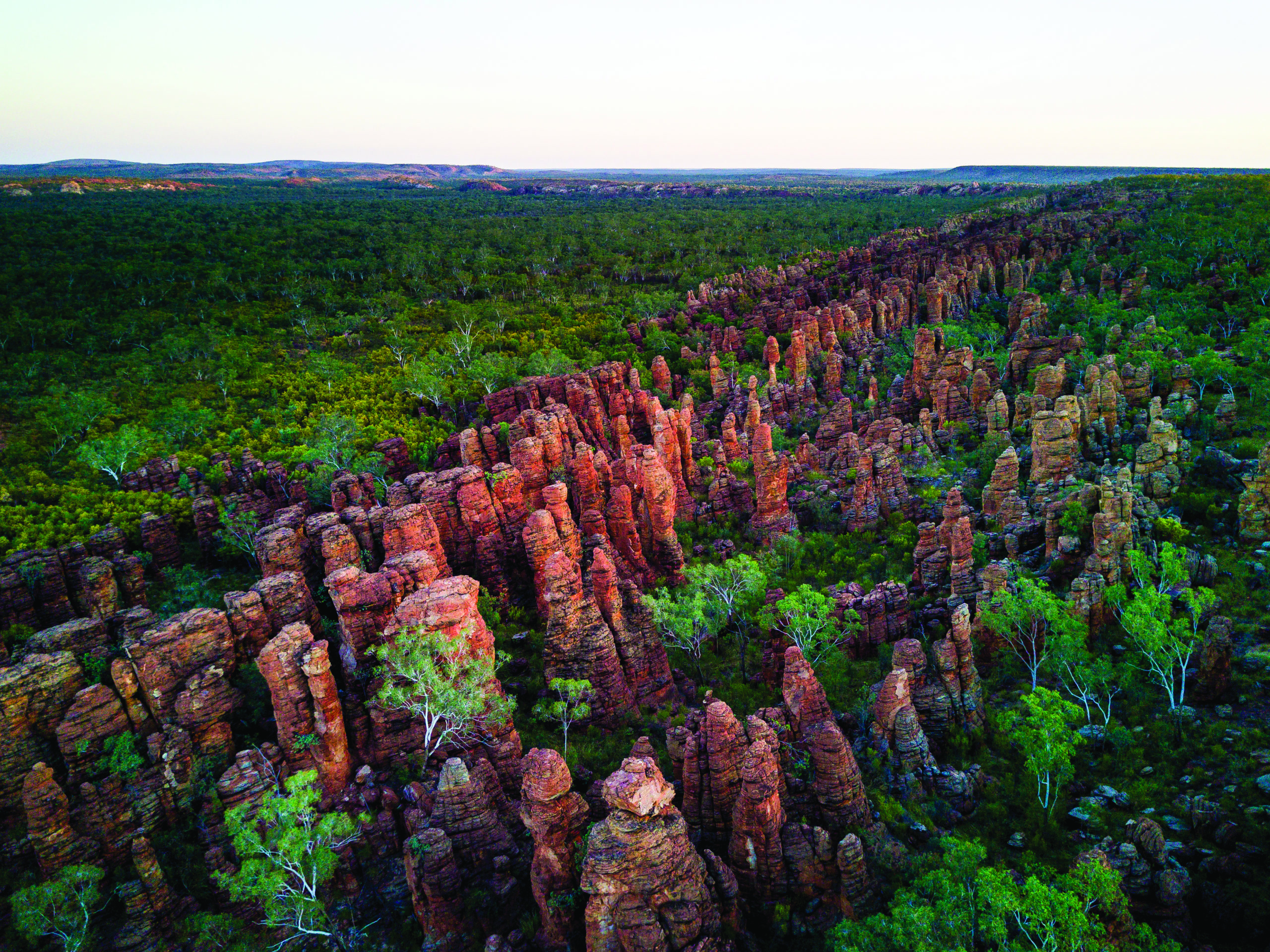

Southern Lost City
Limmen National Park, Northern Territory
Limmen is hardly the best-known national park in Australia. Unless you’re a keen barramundi fisher, you’ve probably never heard of it. But this remote corner of the Northern Territory’s Gulf region, about 700km south-east of Darwin, is home to stunning rivers and wetlands and some remarkable sandstone formations, AKA the Lost Cities. A guided walk through the bizarre, otherworldly pillars of the Southern Lost City, some of which feature gravity-defying rocks balancing on top of each other, is a must-do. A helicopter flight, taking off from the nearby 1-millionacre wildlife sanctuary, Lorella Springs Wilderness Park, offers a whole new angle on the scene. Soak up the orange-red glow and ponder the timelines involved here. These sandstone columns are about 1.5 billion years old, making this some of the oldest rock in the world.
See the Southern Lost City from the air on an Outback Spirit Leichhardt’s Savannah Expedition: outbackspirittours.com.au.

Hill Inlet Lookout
Whitsunday Island, Queensland
Is there a more beautiful spot-on earth than the Whitsundays? Head out on a sailing adventure that drops anchor off Whitsunday Island and judge for yourself. The first thing to do after you set foot on Whitehaven Beach, famously home to some of the whitest sand in the world, is to walk off it, so you can appreciate the scene from above. Follow a path trodden by the Whitsundays’ Traditional Owners, the Ngaro people, for about 700 metres through the bush, to the sound of birdsong, and up to Hill Inlet Lookout, from where you can look down as moving tides create ever-changing swirls among the aquamarine waters and silica sand. You’re likely to see birds, stingrays, and even whales if you’re here in winter, and the panorama of the islands and Coral Sea is pretty much how you’d imagine a tropical paradise to look. How does the view from up high compare with a sea-level perspective? You’ll just have to stroll back down for a swim to find out.
Visit the lookout on a Camira Sailing Adventure: cruisewhitsundays.com
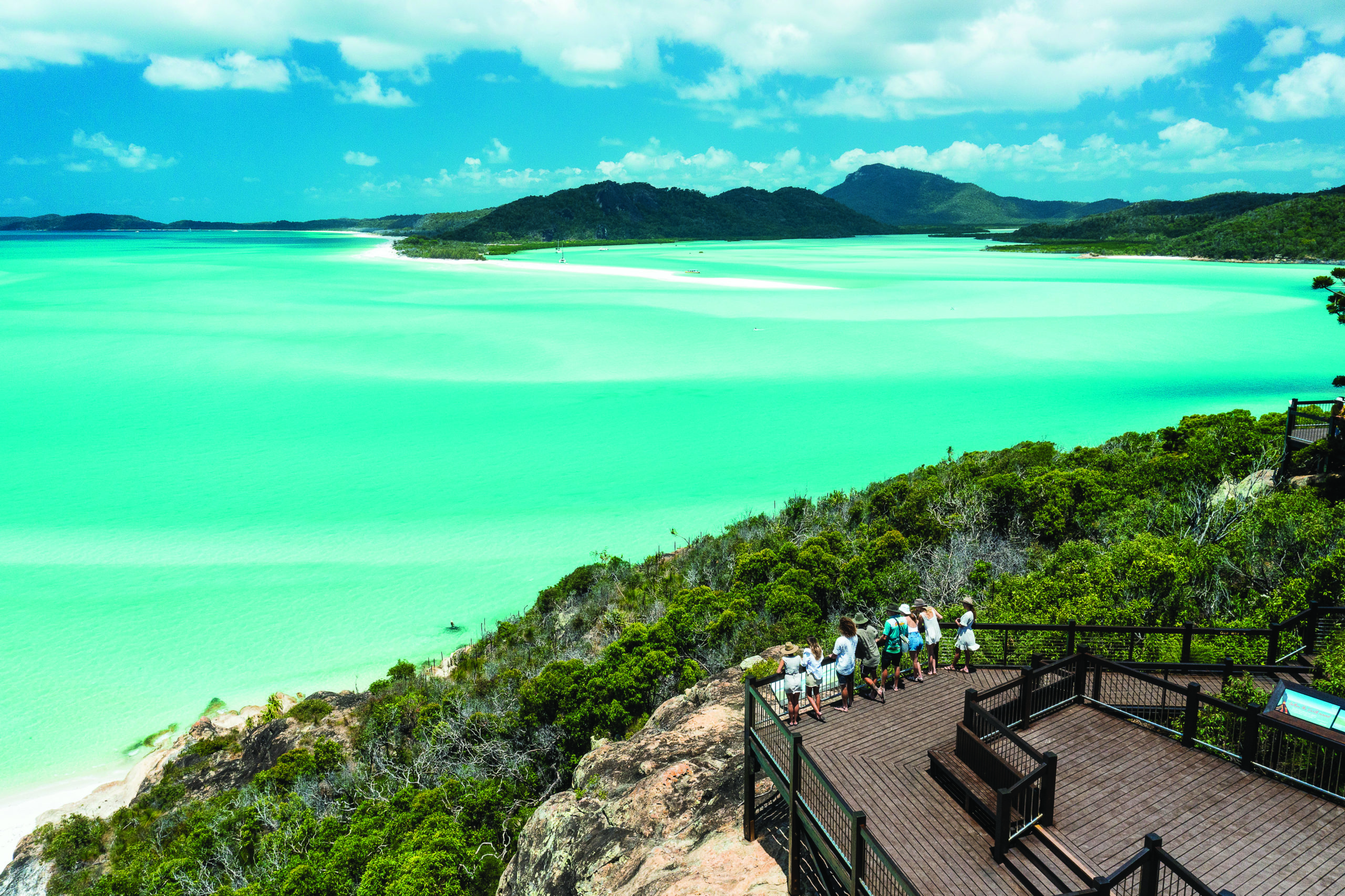
Horizontal Falls
Talbot Bay, Western Australia
When the enormous 12-metre tides of Talbot Bay in WA’s Kimberley region change and the flows reverse, causing vast amounts of water to squeeze through the narrow gaps in the McLarty Ranges, the result is a remarkable phenomenon known as the Horizontal Falls. If you visit, you’ll experience an adrenaline-filled ride through the falls in a custom-built boat, but before you do, you’ll take an incredible flight over this stunningly beautiful corner of Australia. Taking off from Broome in a seaplane, you’ll head up the coast over the dramatic red earth, white sand and blue ocean of Cape Leveque, across the turquoise waters studded with the 1,000 islands of the Buccaneer Archipelago, and then circle over the Horizontal Falls before touching down on Talbot Bay.
Drop in on the Horizontal Falls by seaplane, visit: horizontalfallsadventures.com.au.

Wineglass Bay
Freycinet National Park, Tasmania
You need to get a bit of height to really appreciate Wineglass Bay’s perfect curves, and hopping aboard a helicopter does the trick nicely. A scenic flight over Freycinet National Park takes in not only the impossibly beautiful clear waters and white sand of Wineglass Bay, but also the mountains, pink sea cliffs, rocky coves, and wooded hills and headlands of this remarkable peninsula on Tasmania’s east coast. Wineglass Bay was named, somewhat gruesomely, after the blood that flowed here during whaling days. But don’t let that put you off. This is one of Australia’s most iconic aerial views, and for good reason. From Great Oyster Bay on the western side of the peninsula to the surf on the east, and from the Hazards mountain range in the north to Schouten Island in the south, it is a landscape that lives up to the hype.
Fly over Wineglass Bay with Outback Spirit: outbackspirittours.com.au.
Wilpena Pound
Ikara-Flinders Ranges National Park, South Australia
Another iconic Australian landscape that deserves to be seen from the air, Wilpena Pound is a huge, natural, mountain amphitheatre that sits proud in the vast sprawl of the South Australian outback, like an enormous meteorite crater. No meteorite was involved; the mountain ranges that enclose the pound actually began to form 800 million years ago as sediment in an ancient sea, before tectonic activity folded them into mountains, and time eroded them down to their present size. The timescale is hard to fathom, and so is the landscape, the scale of which can be appreciated in dramatic fashion aboard a scenic flight over this wonder of geology. Also known by its Adnyamathanha name of Ikara, meaning meeting place, the pound sits at the southern end of Ikara-Flinders Ranges National Park, a spectacular land of red cliffs and gorges, abundant wildlife and Aboriginal rock art.
Fly over Wilpena Pound with Outback Spirit: outbackspirittours.com.
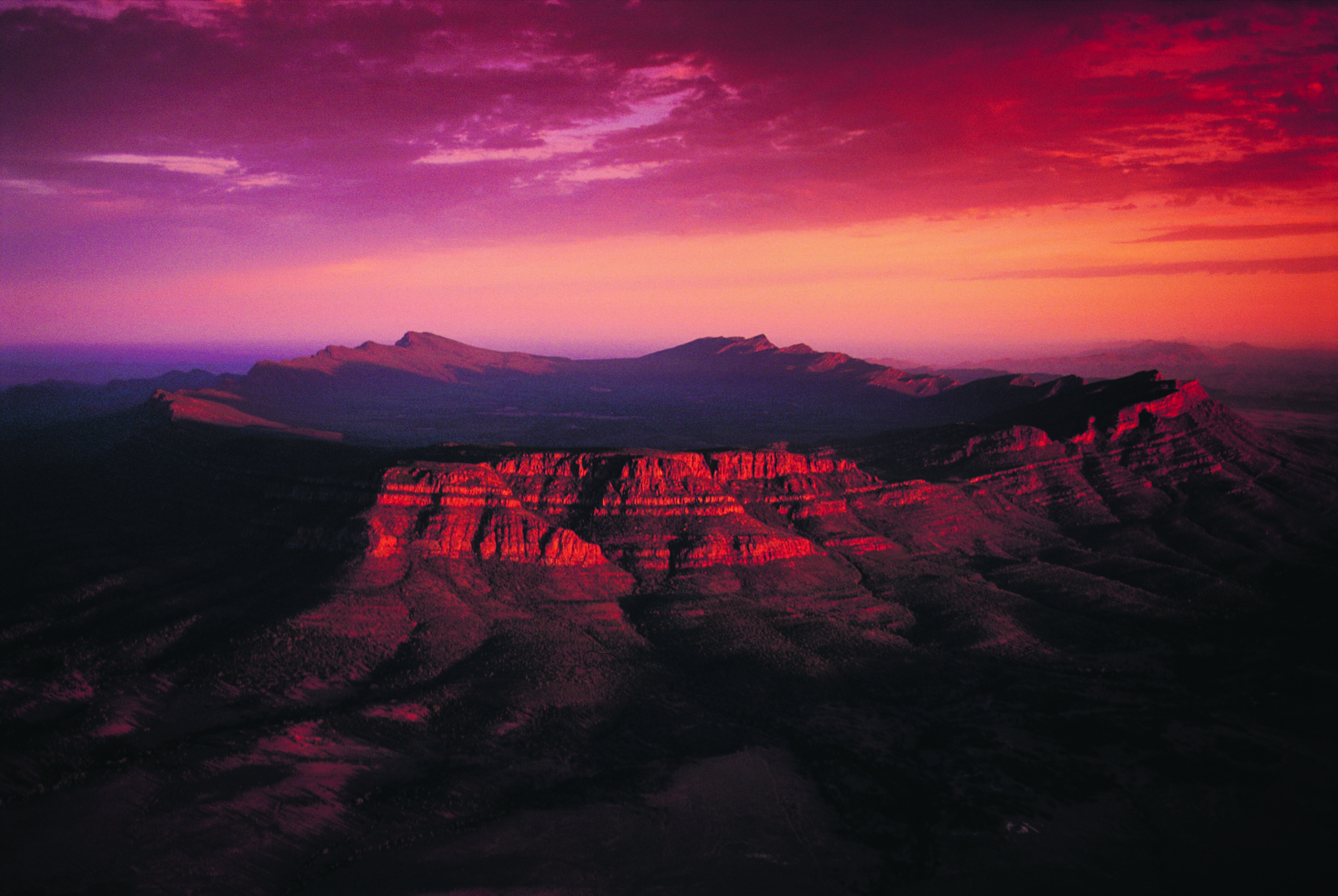
Blue Pool
Bermagui, NSW
You can find about 60 ocean pools still in use up and down the New South Wales coast. One of the southernmost, the Blue Pool at Bermagui on the Sapphire Coast, just a couple of hours north of the Victorian border, is also one of the most spectacular. This famously photogenic swimming hole was built in the 1930s, crafted from a natural rock pool at the bottom of a steep cliff face just a few minutes out of town. Of course, it’s a beautiful place to swim, but before you head down, take some time to admire the views from the lookout. Head there for sunrise at low tide to maximise the magic, with the rocks glowing orange, the still pool reflecting the dawn sky, and the ocean glistening. You might see seals, dolphins or whales soaking up the good vibes, too.
Discover more about the Sapphire Coast: sapphirecoast.com.au.
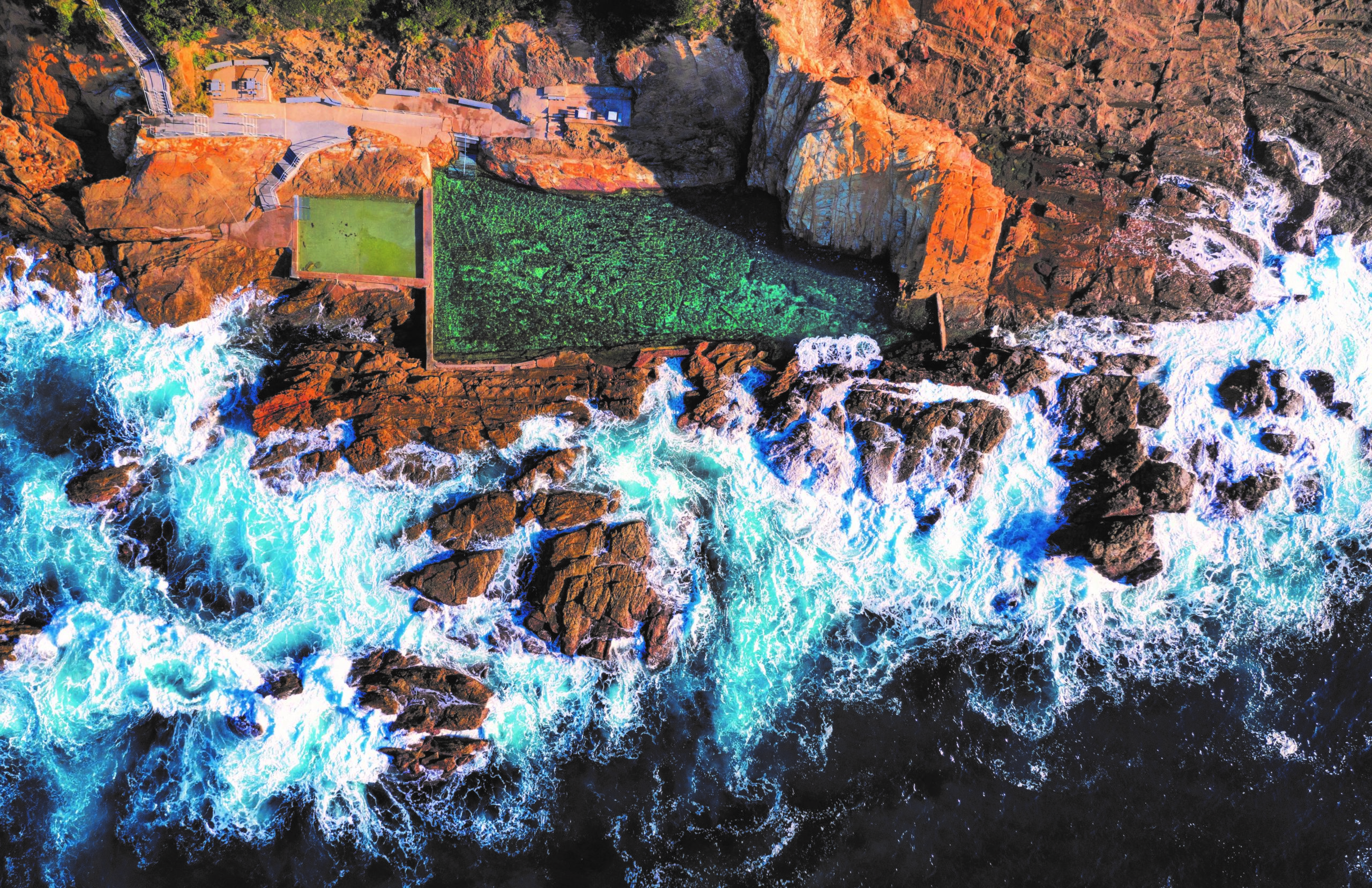
Teddy’s Lookout
Great Ocean Road, Victoria
You’re spoilt for choice when it comes to lookouts here – but one must-see is Teddy’s Lookout in the pretty beachside town of Lorne. Drive to the top end of George Street, then take an easy stroll along a walkway through the bush and you’ll find yourself on a platform 113 metres above sea level, offering superb views out to Bass Strait – people even claim to have seen aurora australis, the southern lights, from here. Down below, the St George River spills into a cove, while the Great Ocean Road hugs a hillside before disappearing around a bend. A lower platform, a few minutes’ walk away, offers a new perspective: the river winding through the lush hills. No one seems quite sure who Teddy was, but you can’t blame him for spending a bit of time up here.
Learn more about the Great Ocean Road: visitvictoria.com.


Sign up below to receive our e-newsletters featuring the latest news, exclusive offers and much more from Journey Beyond and Horizontal Falls Seaplane Adventures.